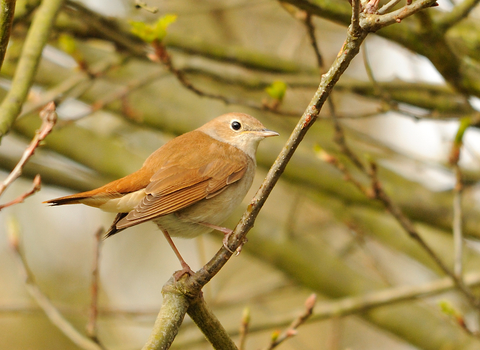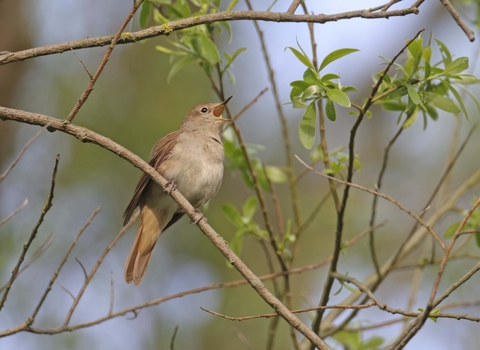
©Amy Lewis

©Chris Gomersall/2020VISION
Nightingale
The melodious song of the nightingale is the most likely sign of this bird being about. Shy and secretive, it sings from dense scrub and woodland, day and night.
Scientific name
Luscinia megarhynchosWhen to see
April to SeptemberSpecies information
Statistics
Length: 16cmWingspan: 24cm
Weight: 21g
Average lifespan: 2 years
Classified in the UK as Red under the Birds of Conservation Concern 5: the Red List for Birds (2021).
About
A shy bird, the nightingale is about the same size as a robin and a summer visitor, arriving here in April and leaving in September. Nightingales nest in dense scrub, from where they sing their famously beautiful melodies throughout the day and at night.How to identify
The nightingale is best recognised by its song. If spotted, it is a robust, broad-tailed, plain brown bird without the streaks of the dunnock or the red-breast of the robin.Distribution
Breeds in South East England, mainly south of the Severn-Wash line.In our area
Suffolk Wildlife Trust are working hard to create wilder areas of scrub for nightingales on many of our reserves, good examples being Arger Fen and Black Bourn Valley.
We also encourage farmers and landowners to develop these wild, ‘messy’ areas benefiting not just nightingale but also many other species too.
Did you know?
Nightingales are famously the best singers of all UK birds, their harmonies immortalised in literature throughout history and inspiring the likes of Homer, Milton and Keats.Suffolk Wildlife Trust are working hard to create wilder areas of scrub for nightingales on many of our reserves, good examples being Arger Fen and Black Bourn Valley.
We also encourage farmers and landowners to develop these wild, ‘messy’ areas benefiting not just nightingale but also many other species too.
